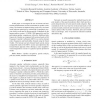Free Online Productivity Tools
i2Speak
i2Symbol
i2OCR
iTex2Img
iWeb2Print
iWeb2Shot
i2Type
iPdf2Split
iPdf2Merge
i2Bopomofo
i2Arabic
i2Style
i2Image
i2PDF
iLatex2Rtf
Sci2ools
ICASSP
2011
IEEE
2011
IEEE
A logarithmic based pole-zero vocal tract model estimation for speaker verification
In this paper we investigate the use of formant and antiformant measurements of nasal consonants for speaker verification. The features are obtained using a pole-zero vocal tract model estimate optimized by minimizing a logarithmic criterion which is motivated by the perception of amplitude by the human auditory system. A GMM-UBM approach is used for performing speaker comparisons within the likelihood-ratio framework. Results are compared with systems based on Mel Frequency Cepstral Coefficients (MFCCs) as well as formant center frequencies and bandwidths obtained using the Snack Toolkit. The formant and anti-formant based system attains comparable results to the MFCC system and outperforms the formant-based approach while offering a more straightforward interpretation in terms of a physical speech production model.
Related Content
| Added | 20 Aug 2011 |
| Updated | 20 Aug 2011 |
| Type | Journal |
| Year | 2011 |
| Where | ICASSP |
| Authors | Ewald Enzinger, Péter Balázs, Damián Marelli, Timo Becker |
Comments (0)

